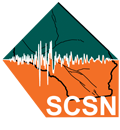Last updated April 7th, 2020
Event
- 03 Apr 2020 18:53:18 PDT, (33.490, -116.507), depth 10.4km.
- 17km ESE of Anza, California
- The highest intensity shaking recorded by an instrument was MMI VI, strong shaking, at 9km from the event epicenter. Felt (mostly weak/light) shaking was reported along much of the length of the southern California coast, from Santa Monica to San Diego, with over 19,000 felt reports submitted to the USGS Did You Feel It? website.
Aftershocks
- As of 07 Apr 2020, 02:21PM PDT, there have been 1426 aftershocks recorded. There have been 8 aftershocks of M3 or larger, and 68 aftershocks of M2 or larger.
- The largest was M3.8 (smallest M-0.1).
- More aftershocks may be expected in the next few days, the largest expected is approximately 1 magnitude unit smaller than the mainshock.
- There is a small chance (about 5%) that a larger quake could occur, with the likelihood decreasing over time.
Possible Foreshocks
- There were 3 events during the 3 days prior to the earthquake (within a 10 km radius).
- The largest was M1.0 (2020/04/02).
Historical Seismicity
- Since our records began in 1932 we’ve had 42 events of M4 or greater within 10km of today’s event.
- The largest historic event was M5.6 on 2005/06/12.
- The most recent historic event was M5.2 on 10 Jun 2016.
Faults
- CFM fault associations: most likely Clark fault (San Jacinto fault zone); north segment (50%). Alternates: Not associated with a CFM modeled fault (3%), Other CFM faults (47%).*
- Nearby faults: San Jacinto fault zone, Anza section (Clark fault) (1.5 km), San Jacinto fault zone, Anza section (Buck Ridge fault) (1.9 km), San Jacinto fault zone, Anza section (2.9 km), San Jacinto fault zone, Coyote Creek section (Coyote Creek fault) (3.6 km) and San Jacinto fault zone, Coyote Creek section (7.4 km).**
- The San Jacinto fault zone is the most active fault, in terms of regular seismic activity, in southern California. The focal mechanism suggests this was a right-lateral strike-slip earthquake, consistent with the motion of the San Jacinto fault (and the Pacific:North American plate boundary motion).
Additional Information
- Links for: USGS earthquake page, ShakeMap, DYFI, waveforms.
- Visit our special reports page for further information on local notable earthquakes:
Below are the waveform data associated with this sequence, as recorded in our Live Seismograms Feed. The mainshock m4.9 and subsequent m3.5+ aftershocks can be viewed in the playlist below.The closest stations to the epicenter represented below are CI.HMT2 and CI.WWC at approximately 51 km away.
*Earthquakes can occur both near or on major known faults, and in places where no clear fault zones are known. Using the statistical method of Evans et al. (in prep. 2019) the location and focal mechanism of this earthquake suggest the above association with modeled faults in the Community Fault Model (CFM) provided by the Southern California Earthquake Center (SCEC) and Harvard University. Note that the CFM fault association may be different from the nearby faults list. Differences may arise due to different fault databases, and because the CFM fault association uses the hypocenter with relation to subsurface 3-dimensional fault orientation models, while the nearby faults list utilizes mapped surface traces as they relate to the epicenter.
CFM Fault: SCEC CFM 5.0 Fault name and closest segment if available; The CFM is maintained by Harvard University, Dept of Earth & Planetary Sciences.
Probability: The probability in percent the earthquake is associated with this fault.
SCSN: Caltech/USGS Southern California Seismic Network
**U.S. Geological Survey and California Geological Survey, 2006, Quaternary fault and fold database for the United States, accessed 2015, from USGS web site: https://earthquake.usgs.gov/hazards/qfaults/
This information is subject to change as more up-to-date data become available.






